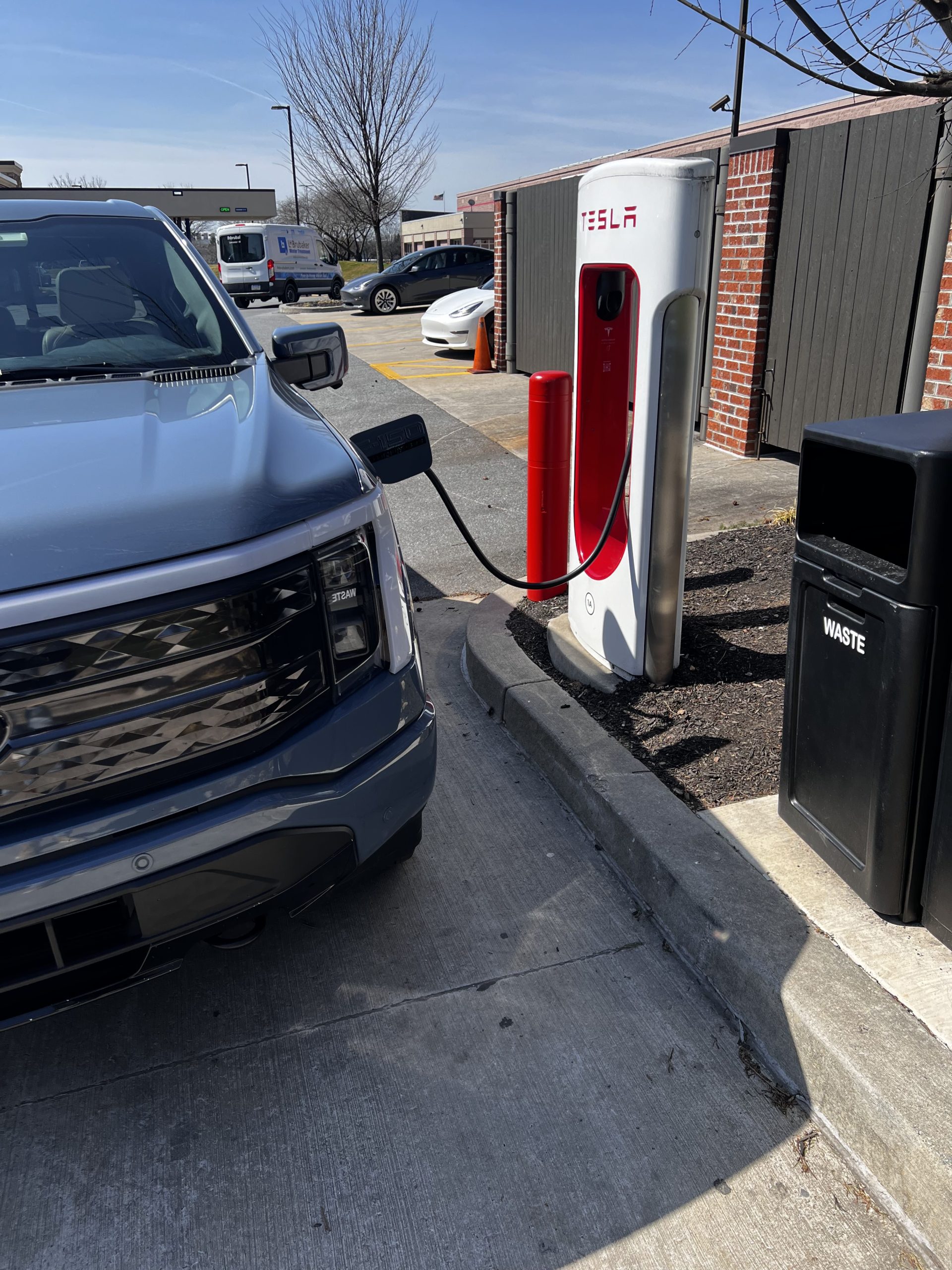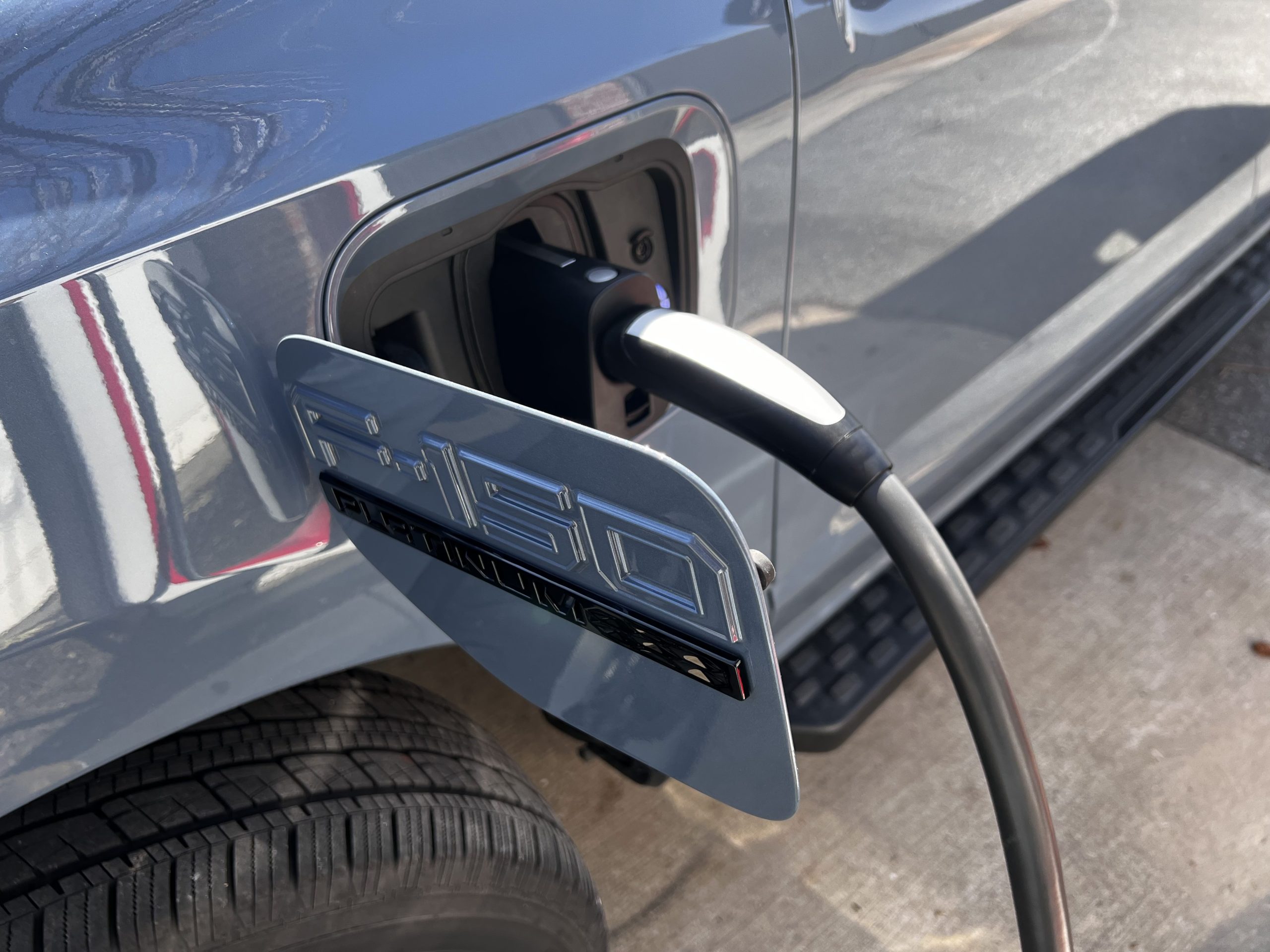Update 4:33 pm: Charge rates updated for accuracy. FordPass statistics were incorrect.
Ford and Tesla unified the electric vehicle community by announcing a strategic decision to collaborate.
Last month, Ford gained access to Tesla’s Supercharger Network, giving non-Tesla EV drivers their first opportunity to charge at its piles across North America.
Ford was pleasant enough to send an F-150 Lightning to my house, drop it off, and allow me to drive it for three days. They also sent a Charging Adapter, which was necessary for using Tesla Superchargers.
The truck arrived at my house early Monday morning, and I was sure to take it for a spin to deplete some of the range before I drove it to my nearest V3 Supercharger. This was my first bit of criticism, as the closest Supercharger that would enable the F-150 Lightning to charge was around 45 minutes away. It is not the closest Tesla Supercharger to me, as there is one just ten minutes away, but its V2 capabilities would not allow me to charge a non-Tesla EV.
Ford announces Tesla Supercharger access to F-150 Lightning, Mustang Mach-E drivers
The truck was great, but that’s another story altogether.
First Impressions
I arrived at the first Supercharger on Monday evening, ready to give this a first go. I pulled into a spot in a row of unoccupied superchargers; the Lightning’s charging port is located just behind the left front tire, so you need to take up two spots, something that Tesla is working on.
It was super tight to get the cable to reach. I had some room to pull forward, admittedly, but I was driving a truck that I didn’t own, and I didn’t want to take the chance of scraping the underbody of the vehicle. Even with repositioning myself and trying to angle the truck in order to reach the cable comfortably, it was hard to get the cable to get to the connector.
A few extra feet would help even the most cautious drivers charge more easily, which I believe is important.
Overall, it was a good experience. My charging statistics for this session were:
- Charging Power – 106 kW
- Energy Added – 37.4 kWh
- Time Charged – 21 minutes
- Distance Gained – 96 miles
- Cost – $21.16
It was not an overwhelmingly time-consuming process. It was quick, it was easy, and it was nice to have access to a Supercharger. When I have Ford EVs, I usually have to charge at my local grocery store on a low-speed Volta charger, which will give me around 10-12 miles per hour.
Second Charging Session
My second session was much better. I was able to get into a Supercharger stall that was put on the side of the spot as it was an end space, so it was easier and much more reasonable to pull into.
There was significantly less tension on the Supercharger cable, which I think will increase longevity and keep the number of operable stalls up.
This session was smoother in terms of pulling in and charging. While longer cables will eliminate a lot of the problems I had during the first charging session, Tesla’s end-spot Superchargers are super ideal for non-Tesla EVs. This was my preferred space, and I would have used it the day prior if another vehicle wasn’t already utilizing it.
My charging stats for this session were:
- Charge Power – 106 kW
- Energy Added – 48.3 kWh
- Time Charged – 33 minutes
- Distance Gained – 115 miles
- Cost $22.08
Quality of the Adapter
The adapter Ford sent along was super quality, solid, and heavy. It felt like a piece of necessary equipment that is designed to last several years and won’t break on you due to inferior quality.
It was packaged nicely and included a nice message from CEO Jim Farley. It simply attaches to the Tesla Supercharger Cable and goes into the Ford EV, locking in place:
Forgot how much I love driving the Lightning, honestly my favorite EV to cruise around in!!
Ford overnighted me the adapter for Superchargers as well! pic.twitter.com/0VGE0AKxj6
— Joey Klender (@KlenderJoey) March 11, 2024
I was impressed by the quality of the adapter and I believe it would last years for Ford EV owners who plan to use it to access Superchargers.
Final Thoughts
Ford EV drivers are going to use Tesla Superchargers for years to come, and I think that what I experienced was a good start of the overall charging experience.
Everything was high-quality, fast, effective, and easy to use. It felt nice to roll into a Tesla Supercharger and gain adequate of range in a short period of time, and it was something that I feel a lot of EV drivers will appreciate, even if it is a tad pricey at this point in time.
I think that the lengthening of Supercharger cables will pay dividends, but I also think that Tesla could build new Supercharger stations with mandatory end spot positioning. This enables easier access to the Superchargers for non-Tesla EVs.
I’d love to hear from you! If you have any comments, concerns, or questions, please email me at joey@teslarati.com. You can also reach me on Twitter @KlenderJoey, or if you have news tips, you can email us at tips@teslarati.com.










